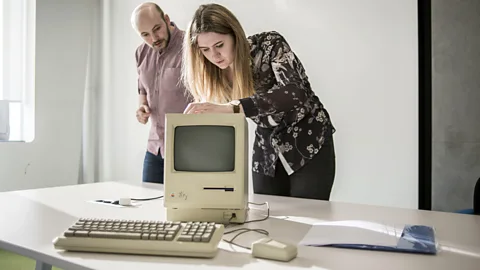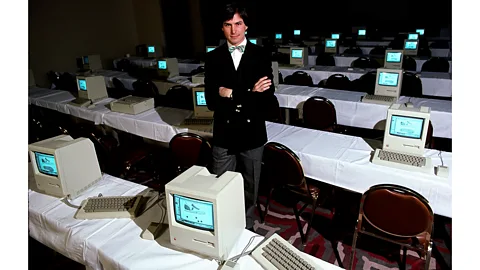The Apple Macintosh was first released 40 years ago: These people are still using the ageing computers
 Alamy
AlamyOn 24 January 1984, the Apple Macintosh 128K personal computer was unveiled to the world, but 40 years later it still has a loyal following of fans – and s.
David Blatner still has practically every Macintosh computer he ever bought. But one in particular stands out – the first. He re the neat way the screen was laid out; the glossy manual; the cassette tape tutorials explaining how to use the machine. It was everything he felt a computer should be.
He had seen early iterations of personal computers as a young child. He used to ride his bicycle to Xerox's Palo Alto Research Center in California where his stepfather worked in the 1970s. There, Blatner got to try early personal computers such as the Alto, which had a graphical interface and a mouse.
"A computer that would work for a single person – that was, in itself, mind-boggling," re Blatner, who is now president of CreativePro Network, an online resource for creative professionals.
But it would take another decade before he got one of his own – with the arrival of the Apple Macintosh.
On 24 January 1984, a man called Steve Jobs got up on a stage and heaved a beige box out of a carrying case, shoved a floppy disc into it, and stood back. As the theme from Chariots of Fire played, the word "Macintosh" swept across the tiny computer's screen and a series of monochromatic images flashed up. The captivated audience – of Apple shareholders – went wild.
By today's standards, the tiny screen, boxy form and rudimentary graphics of the original Macintosh look ludicrous. The device was not even the first personal computer. But it was, arguably, the first to change the world. And Steve Jobs’ flashy launch day presentation, at the Flint Center in Cupertino, California, became a template for his many later appearances introducing subsequent Apple hardware – including the iMac and iPhone.
Today, the Mac 128K – so called because it came with 128kb of Random Access Memory, or RAM – is a museum piece. Apple stopped producing the computers in October 1985 and discontinued software for them in 1998. But a handful of diehard fans still use their Mac 128K computers today – although not without frustrations. The machines are extremely limited due to their small amount of memory. If you want to check out the 128K's specifications, Apple actually lists them on its website.
Even with its diminutive memory, no modem or ability to connect to the internet, and rudimentary graphics, there is a community of avid fans who delight in poring over this seemingly ancient hardware. David Greelish, a computer historian in Florida who is releasing a documentary about the 128Ks predecessor the Apple Lisa this month, notes the ingenuity of the 128K's original circuit board. "It's got everything: ROM, RAM, processor and all the input-output," he says. "Everything there in a beautiful little integrated square board. For 1984, it was amazing."
 Getty Images
Getty ImagesThe original Macintosh can still sell for as much as a modern computer. And for collectors they are a piece of computing history, with the signatures of the team who built it moulded into the plastic of the rear casing.
Some Mac 128K owners, however, use the devices to play quirky games like Frogger or Lode Runner on their treasured machines. All in black and white. The first Macintosh with a colour screen, the Macintosh II, only arrived in 1987.
The Centre for Computing History in Cambridge, England, is one of many collections that feature a functioning 128K. "It’s 40 years old and it’s still going," says Lisa McGerty, chief executive, who re the introduction of Macintosh computers as a "massive" improvement for people in the printing and publishing business. Apple's graphical printer, the ImageWriter, was released shortly before the 128K.
McGerty’s colleague Adrian Page-Mitchell, collections officer, says it’s not always easy to keep these decrepit Macintoshes functioning. An earlier 128K that had been on display for a long time at the Centre for Computing History eventually failed and "couldn't be fixed", he says.
Sometimes Macs show their age in strange ways. Steven Matarazzo, a YouTuber and computer collector, says that one of the machine’s capacitors can sometimes degrade over time, meaning that the 128K's screen won’t work properly – it'll appear slightly squished.
Last year, he published a YouTube video about an apparent prototype version of the 128K that turned up. It wasn't working so its owner asked Matarazzo if he could take a look at it. Before long, Matarazzo had the device functioning again. He studied every inch of this early Mac in detail, enthusing about tiny differences between it and the version that made it to market – such as the little Apple logos imprinted on the rubber feet of the prototype. Those weren’t there in the final design. It’s a bit like archaeology for gadgets, he explains.
"You try and put this together – what was the process here, how early was this, how late was this">window._taboola = window._taboola || []; _taboola.push({ mode: 'alternating-thumbnails-a', container: 'taboola-below-article', placement: 'Below Article', target_type: 'mix' });
